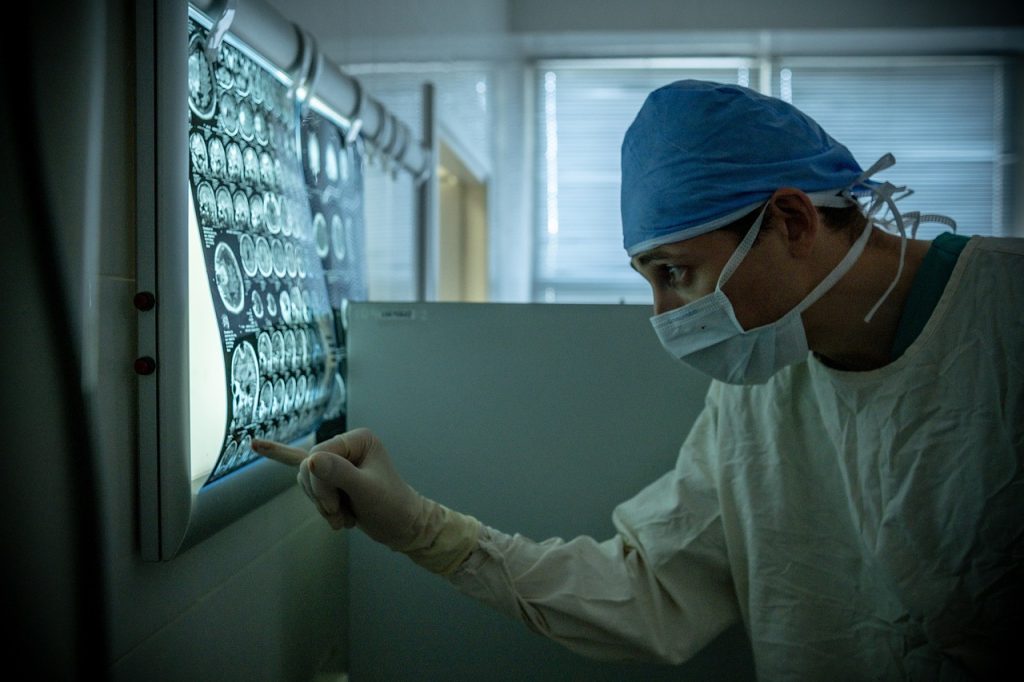There are people around the world who do not experience pain – at least not in the way that we do. You might think that this would be some sort of superpower. You would be wrong. Those born with Congenital insensitivity to pain (CIP) usually don’t live beyond early childhood due to complications associated with repeated damage to their tissues (1).
We would not be here today if it were not for pain. Our ancestors would have died long ago due to injuries and infections. Yes, the experience is unpleasant, but if it were not unpleasant then we wouldn’t have the drive to act to avoid potential harm.
Pain is an Experience
The International Association for the Study of Pain says that;
“pain is an unpleasant sensory and emotional experience associated with actual or potential tissue damage or described in terms of such damage”. Note the terms “experience” and “actual or potential”
Note the terms “experience” and “actual or potential”. Pain is not a thing you can point your finger at – it’s not a single nerve signal or a single chemical – but it is an experience. Just like how experiencing happiness or sadness is an individual experience that is a result of many factors.

There are, of course, times when pain works exactly like you might expect. Naturally, significant injury can often result in significant pain. This pain often eases as time goes on – usually easing quite quickly over a course of minutes or hours, and often taking days or even weeks and months to subside completely. However, this type of pain is not usually disabling, and those it afflicts generally get back to doing whatever they have always done. It is when pain lingers, is excessive, or more disabling that it really causes problems…
Pain is a Protector
Some of the leading pain scientists in the world today tell us that pain is our protector (2). In life we expose ourselves to potentially harmful situations every day. It is key that we have protective responses to reduce the risk of harm and injury – otherwise we might end up like those who suffer from CIP (above).
Pain, as an experience, is unpleasant and demands our attention – it demands that we act in response to it. This is great, as if it were not unpleasant then why would we bother acting in a way to get away from it? In this way, we could look at pain like an alarm system, or a guard dog – warning us about potential danger and telling us to do something about it.
However, as we know, alarm systems and guard dogs don’t always work exactly how we might expect. Occasionally they malfunction and become too sensitive – being set off by things that wouldn’t usually set them off (such as a small bird or a car that is simply driving past the front of the house). In a similar way, our own pain system can become over-sensitive and begin to set off the alarm (i.e. pain) when we are not really in any danger at all.
For more on this, take a look at THIS MAGNIFICENT VIDEO.
Shark Attack
Bethany Hamilton – 13 years of age and aspiring pro-surfer – was paddling on her board in the idyllic waters off the coast of a Hawaiian island when she was ambushed by a 14ft tiger shark (3). The shark clamped onto her left arm just below the shoulder, ripping it off. Bethany felt no pain during the attack or afterwards as she was brought back to shore by other surfers. She survived the ordeal, going on to become a pro surfer despite only having one arm.
This is an example of massive tissue damage resulting in no pain. There are also cases where massive pain can result from no damage.
The Agonising Case of a Nail in a Boot
Below is an incredible excerpt from an Emergency Department doctor.
“A builder aged 29 came to the accident and emergency department having jumped down on to a 15 cm nail. As the smallest movement of the nail was painful he was sedated with fentanyl and midazolam. The nail was then pulled out from below. When his boot was removed a miraculous cure appeared to have taken place. Despite entering proximal to the steel toecap the nail had penetrated between the toes: the foot was entirely uninjured.”
– Fisher, J.P., Hassan, D.T. and O’Connor, N., 1995. Minerva (Emergency Department Case Study). BMJ. (4).
Love Eases Pain
We can safely say that love eases pain. In a beautiful scientific study, women were exposed to a painful amount of heat (from a little metal box strapped against the skin) (5). The researchers then looked at how 4 different scenarios affected the amount of pain they felt – 1. their partner watched, 2. their partner touched their hand, 3. a stranger touched their hand, or 4. nobody interacted with them.
Those whose partners touched their hand during the experiment experienced less pain than those in the other groups. Interestingly, the more empathetic that their partner was, the less pain they reported (6). The researchers go on to describe how touch appears to be a means of communication between intimate partners – promoting synchronisation of their physiological states (e.g. matching heart rate and breathing rate).
Why you should look away from needles

More researchers have shown how the act of viewing a needle entering the skin will increase the pain experienced.
In this study, participants received a painful electrical shock to their hand. At the same time, they watched a screen displaying either a needle or cotton bud being pressed into their hand at the same point as the shock (this did not really occur – but the screen lined up with their hand to make it appear to them like it was). Those who viewed a needle experienced greater pain, despite receiving the exact same electrical shock as those who viewed a cotton bud (7).
This is a simple and effective example of how vision and preconceived ideas (e.g. a needle is painful; a cotton bud is not) can change how we experience pain. This helps to support the fact that scary beliefs and fear of pain can actually worsen pain and increase the risk of pain becoming persistent (2) (e.g. the idea that a disc is ‘popping out’ or that a joint is ‘bone-on-bone’ are scary thoughts that no doubt make the pain experience more distressing than it might otherwise be – more on this in another blog post…).
Scans – We All Have ‘Wrinkles on the Inside’

Scan reports can include lots of confusing and scary findings. While scans can have their use in medical practice, there are many cases where scans are unnecessary. Often, the details of the scan are not adequately explained to the patient, and they walk away with more questions and concerns than answers.
- 96% of athletes under 22 years old with NO PAIN have changes on MRI that many doctors call “abnormal” (if almost everyone has them, maybe it’s more ‘abnormal’ to have a clear scan..?) (8)
- 37% of 20-year-olds; 80% of 50-year-olds; 96% of 80-year-olds, all with NO PAIN have disc degeneration in their spine. Similar percentages have ‘disc bulges’ on scans, but suffer from NO PAIN (9)
- 57% of 20–50-year-olds with NO HIP PAIN will have cartilage and ligament tears in their hips (10)
‘Abnormalities’ do not mean there will be any pain or dysfunction. In fact, it appears that it is in fact extremely ‘abnormal’ to have a completely clear scan. Scans can be useful in some instances – but only in a small percentage of those with pain, and we must interpret the findings with greater understanding.
So-called degeneration is usually present without people even knowing it is there – with some leading scientists suggesting ‘degenerative changes’ could be viewed as ‘wrinkles on the inside’ (2).
For more in-depth discussion on scans (and for a patient’s perspective), listen to THIS ILLUMINATING PODCAST.
Pain is Real
None of this means that the pain experience is not ‘real’. Just because we become aware of different factors that influence and coincide with pain – factors that might be considered to come from a ‘deeper’, more fundamental level (e.g. neurons in the brain) – does not mean that they are more important or relevant than pain itself.
You could compare this to the way that an apple is still real – despite growing from a tree and being made up of many tiny atoms. The apple is still just as real and relevant as the tree and the atoms.
Pain, as an experience, is no less real or important than the things that make that experience possible. (If you are interested in more discussion about reality and experience, listen to THIS INTERESTING PODCAST discussing the experience of consciousness).
In Summary...
This is just a taste of the wonderfully interesting, informative and confusing world of pain science. Pain, in my opinion, will not be fully understood until we fully understand the conscious experience (and I don’t think that is going to happen anytime soon, if ever). That said, there is much that we do understand about pain, what causes it, what influences it and how people recover from persistent pain. More to come on this…
Pain is a protector – like an alarm system or guard dog it warns us of potential danger in the body
Sometimes pain can become overprotective/ too sensitive
The Brain is central to the pain experience – influenced by many factors (like sights, sounds and even the presence of a loved one).
It’s normal to have ‘abnormalities’ on a scan
Useful Resources:
Video: Tame The Beast — It’s time to rethink persistent pain
Podcast on Scans: Empowered Beyond Pain: Episode 14: Low back pain fact 4 with patient voice, Joe: ‘Scans rarely show the cause of pain’
Podcast on the Conscious Experience – Philosophize This – Episode #181 – What if consciousness is an illusion?
References:
- Nagasako, E.M., Oaklander, A.L. and Dworkin, R.H., 2003. Congenital insensitivity to pain: an update. Pain, 101(3), pp.213-219.
- Mosley, G.L. and Butler, D.S., 2017. Explain pain supercharged. NOI.
- Bethany Hamilton surf video interview (on YouTube) – !!SURFER GIRL RIDES WAVE AGAIN AFTER LOSING ARM FROM SHARK ATTACK!! PART 2 OF 2. link: https://www.youtube.com/watch?v=z31MpcULTsI&t=243s (accessed 11/7/23)
- Fisher, J.P., Hassan, D.T. and O’Connor, N., 1995. Minerva (Emergency Department Case Study). BMJ.
- Goldstein, P., Shamay-Tsoory, S.G., Yellinek, S. and Weissman-Fogel, I., 2016. Empathy predicts an experimental pain reduction during touch. The Journal of Pain, 17(10), pp.1049-1057.
- Goldstein, P., Weissman-Fogel, I. and Shamay-Tsoory, S.G., 2017. The role of touch in regulating inter-partner physiological coupling during empathy for pain. Scientific reports, 7(1), p.3252.
- Höfle, M., Hauck, M., Engel, A.K. and Senkowski, D., 2012. Viewing a needle pricking a hand that you perceive as yours enhances unpleasantness of pain. PAIN®, 153(5), pp.1074-1081.
- Rajeswaran, G., Turner, M., Gissane, C. and Healy, J.C., 2014. MRI findings in the lumbar spines of asymptomatic elite junior tennis players. Skeletal Radiology, 43, pp.925-932.
- Brinjikji, W., Diehn, F.E., Jarvik, J.G., Carr, C.M., Kallmes, D.F., Murad, M.H. and Luetmer, P.H., 2015. MRI findings of disc degeneration are more prevalent in adults with low back pain than in asymptomatic controls: a systematic review and meta-analysis. American Journal of Neuroradiology, 36(12), pp.2394-2399.
- Tresch, F., Dietrich, T.J., Pfirrmann, C.W. and Sutter, R., 2017. Hip MRI: prevalence of articular cartilage defects and labral tears in asymptomatic volunteers. A comparison with a matched population of patients with femoroacetabular impingement. Journal of Magnetic Resonance Imaging, 46(2), pp.440-451.

